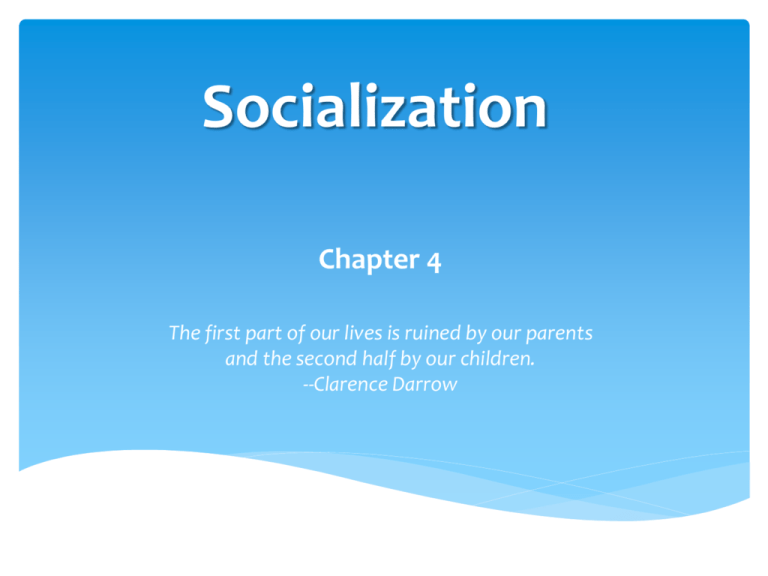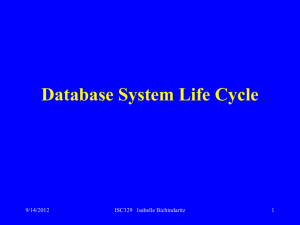Socialization
advertisement

Socialization Chapter 4 The first part of our lives is ruined by our parents and the second half by our children. --Clarence Darrow The Role of Socialization Socialization-learning the attitudes, values and actions appropriate to individuals as members of a particular culture. Personality- the sum total of behaviors, attitudes, beliefs, and values that are characteristic of an individual • No two individuals have exactly the same personalities • Continue to develop throughout their lifetime How do you become you? Nature Sociobiology Perspective- biological basis for all social behaviors, determined by genetic factors Heredity- transmission of genetic traits Examples? Nurture Social-Learning Perspective- Most behavior is learned through observation and understandings of the world around you Cultural Environment- differences in values, beliefs, understandings, etc. Examples? Heredity is vital to development: How to study?……….Twins! Preliminary results lean to both heredity and environment One study of identical twins reared apart found: 1. Both chain smoked the same brand; 2. Chewed their fingernails 3. Same model blue Chevrolet 4. Same dog’s names Differences between twins: Attitudes, values, friends, drinking habits Similarities between twins: Temperaments, voice patterns, nervous habits Perhaps both? Most sociologists believe that personality and social behavior result from a combination of heredity and environmental factors. Almost every example given can be attributed to both forms of personality development. What traits can be both Nature and Nurture? Personalities Athleticism Competition Religion Slavery …WHAT ELSE? Personality Development HEREDITY BIRTH ORDER CULTURAL ENVIRONMENT PARENTS Unique and Wonderful YOU Personality Development HEREDITY Provides biological needs Places limits on what is possible but does not determine behavior Aptitudes: capacity to learn a particular body of knowledge Inherited aptitudes can be encouraged or discouraged by parents BIRTH ORDER Children with siblings often have a different view of the world than do only children Influences personality development: First born- achievement oriented and responsible; conservative in thinking Last born- better in social relationships, affectionate, friendly; risk-takers, intellectual and social rebels Personality Development PARENTS Influenced by characteristics of your parents; affected by: Age of parents Differences between parents Education Religion Economic Status Cultural heritage Occupation CULTURAL ENVIRONMENT Cultures give rise to model personalities” that are typical and valued by members of society; affected by: Gender Subcultural differences THINK – PAIR – SHARE Write down 5 positive things about yourself: 12345Are these products of sociobiology or socialization? What would happen if a child was reared in total isolation? How would they develop a “personality”? Isabelle First six years, lived in almost total seclusion Little contact with people, exception was her mother, who could neither speak nor hear Isabelle’s mother’s parents were deeply ashamed of the illegitimate birth & kept her hidden away Isabelle & her mother escaped Ohio authorities discovered her in 1938 – age 6 Isabelle Isabelle could not speak: made croaking sounds & communicated with simple gestures Strong fear of people Reacted like a wild animal when confronted with an unfamiliar person Scored infant level on maturity tests at 6 yrs. Isabelle Researchers developed a systematic training program to help Isabelle adapt to life After a few days- she made her first attempt to verbalize After two months, she could pass the maturity tests at a 6 yr. old level After 9 months-identify words and speak in sentences At 14 years – in school, well adjusted in the 6th grade Genie In 1970, L.A. social workers become aware of a 13 year old girl who had been neglected and abused Spent most of her life isolated and in a closet- caged like an animal Physically and cognitively impaired Team started to work with her to try to recover what had been lost Genie’s linguistic abilities were severely and irreversibly restricted—mental retardation. Different ideas of SELF: Locke Cooley Mead Piaget Freud Locke’s Tabula Rasa Born as a clean slate Personalities are developed through experience Anyone can be socialized to become a member of a given society despite biological influences Charles Horton Cooley’s Looking Glass Self The self is the product of our interactions with other people Process of developing a self-identity: 1. Imagine how we present ourselves to others-relatives, friends, strangers 2. Imagine how others evaluate us-attractive, shy, intelligent, strange 3. We develop some sort of feeling about ourselves-such as respect or shame Cooley’s Looking Glass Self Individual’s “imagination” of how others view him or her has an effect Can develop self identities based on incorrect perceptions Example: Incorrect reaction to a teacher’s criticism – Student thinks teacher views him as stupid - misconception converted into negative self-identity 1. The teacher criticized me 2. The teacher must think I’m stupid 3. Therefore, I am stupid George Herbert Mead’s Stages of the Self Studied the “Self” Developed a useful model of how the “self” emerges – Role-Taking 3 distinct stages... 1. Preparatory Stage: Children imitate the people around them Example: bang on wood if parent doing carpentry, throw a ball if older sibling is doing the same As they grow older-they become more familiar with using symbols Gestures, objects, language that form the basis for communication 2. Play Stage: Child is able to understand other people’s actions Child becomes able to pretend that they are other people (dress up, play school, etc.) Role taking: Process of mentally assuming the perspective of another 3. Game Stage: Begins around 8 or 9 years old Child starts to consider several tasks or relationships simultaneously Able to understand their social position and the social position of those around them: Ex. Aware of other students in a classroom setting ‘Generalized Others’- Child’s awareness of attitudes, viewpoints and expectations of a society A child will learn courtesy is not to please a parent, but is a widespread social value endorsed by parents, teachers, friends and religious leaders Mead’s Theory of the Self When born, the ‘self’ is a privileged, central position Children tend assume the focus is on them and find it difficult to understand others’ points of view: Egocentric As we develop, this fades but never completely disappears Significant others: those people who are most important to the development of the self Jean Piaget’s Theory of the Self There are four stages in the development of children’s thought processes: 1. Sensorimotor - Young children use their senses to make discoveries-by touch they discover their hands are part of themselves 2. Preoperational – Children use words and symbols to distinguish objects and ideas 3. Concrete operational – Children engage in more logical thinking 4. Formal operational - Adolescents are capable of sophisticated abstract thought and deal with ideas and values in a logical way Sigmund Freud’s Theory of the Self 3 parts to the Conscious Self 1. Id: What you WANT to do Acts on Pleasure Principle: demands instant gratification Pays no attention to the laws or needs of others The Id is inborn – infant needs The id: a primitive part of the personality that pursues only pleasure and instant gratification. Sigmund Freud’s Theory of the Self 2. Superego What you SHOULD do Defines and tells us what society says we should do Acts on Reality Principle The superego: contains our social conscience and through the experience of guilt and anxiety when we do something wrong, it guides us towards socially acceptable behavior. Sigmund Freud’s Theory of the Self 3. Ego What you WILL do Satisfies the id, but understands we cannot always get what we want The ego: that part of the personality that is aware of reality and is in contact with the outside world. It is the part that considers the consequences of an action and deals with the demands of the id and superego.











